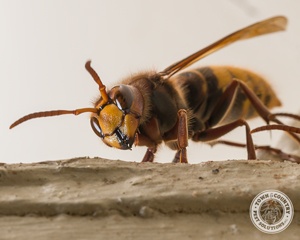
Several wasp species can be found in New York state, including eastern yellow jackets, German yellow jackets, common yellow jackets, the bald-faced hornet and the European hornet. The bald-faced hornet is actually a type of yellow jacket, and the European hornet (Vespa crabro) is the only type of true hornet in the state of New York. The European hornet was introduced into New York state in 1840, and has since spread to many other eastern states. This hornet is exceptionally large at around 2 inches, and they possess smooth stingers that allow them to inflict repeated stings. These hornets are also found nesting on structures, particularly on the siding of houses. Unsurprisingly, the European hornet’s massive size makes them intimidating to residents of upstate New York, but luckily, these hornets are relatively docile when away from their nests, and the pain of their stings is comparable to the pain induced by a common yellow jacket sting. However, European hornet stings can trigger potentially fatal allergic reactions in rare cases.
European hornets mostly feed on insects, but come late summer and early fall, they begin to feed on sweet foods, such as nectar from fruit trees and plant sap. This sudden switch in food preference results from the annual decrease in available insect-meals during the fall season. Like yellow jackets, European hornets become more abundant in residential areas during the fall where homeowners often see the large insects gravitating toward lilac and other shrubs. In response to their sap-feeding activity, shrubs and bushes may be killed, or at least become injured. The European hornet is easy to find within forested areas where they nest in hollow trees, but these hornets can travel incredibly long distances, and their nests are sometimes found on houses, sheds and garages. Unlike yellow jackets and the bald-faced hornet, which build grayish-silver nests, a European hornet nest can be recognized for its brown color, and their nests are usually located in areas that do not receive much sunlight. Unlike other native wasps species, male European hornets are attracted to outside porch lights during the nighttime hours. If a nest should become disturbed, European hornets will not hesitate to attack nearby humans.
Have you ever spotted a particularly large-sized and airborne stinging insect specimen?









